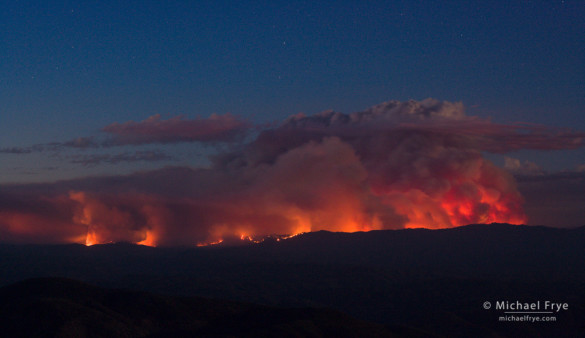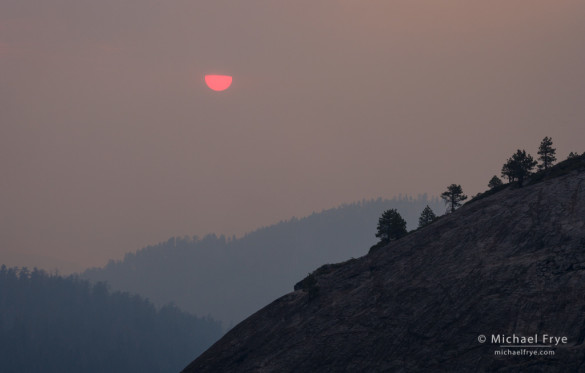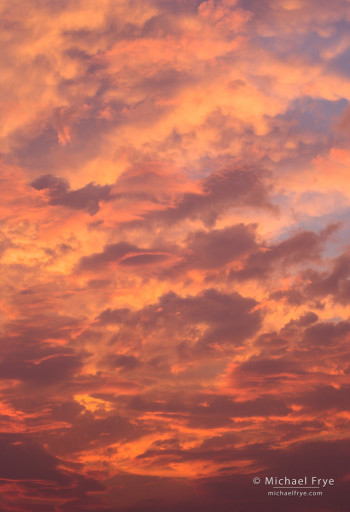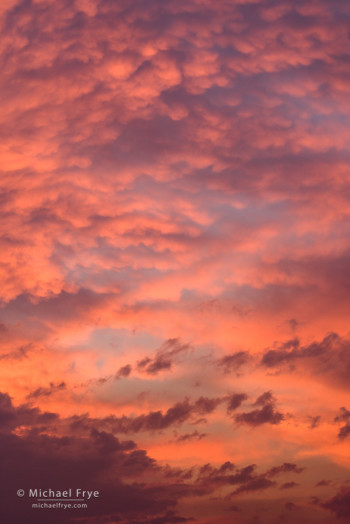Wildfires are common around here in summer and fall. Fire means smoke, and photographers visiting Yosemite during a fire sometimes complain about the smoke. I’ve learned to roll with it. When smoke spoils my plans, I make a new plan. That attitude actually applies to any photographic situation. I can’t control the weather, so I adapt to whatever conditions I find.
On Tuesday afternoon the clouds over the Sierra were spectacular, so Claudia and I headed up the Tioga Road to try to catch some of those clouds lighting up at sunset. As we approached Siesta Lake, however, we became immersed in smoke from the Rim Fire, and realized that the smoke would block the sunset light. So I went to Plan B, my standard plan in these situations, which is to photograph the fire itself.
The Rim Fire is west of the park near Highway 120. We thought we might find a good view from the Crane Flat lookout tower, but unfortunately some low trees blocked the view. So we drove back up the Tioga Road and found a spot with a better view down the canyon toward the fire, where I made the photographs below, with the red sun setting through the smoke, and then of the smoke-tinged clouds at sunset.
Then last night we drove to a hill near our house in Mariposa with a distant view of the southern part of the fire. As the sky darkened, the red glow from the fire, lighting up the underside of the smoke, was incredible. The photograph above was a 15-second exposure, made about an hour after sunset.
I always have mixed feelings about photographing fires. On the one hand, fires are dramatic, and beautiful, and highly photogenic. They present wonderful and unique opportunities for photographs. And I understand how fire is a necessary and natural part of the ecosystem here.
On the other hand, I know that fires cause great destruction. Firefighters are risking their lives to fight the Rim Fire. Two homes have been lost, and several thousand houses are threatened.
The Rim Fire grew from 16,000 acres to 53,000 acres yesterday. It’s already the largest fire in the this part of the state since the Stanislaus Complex Fire in 1987, which burned 147,000 acres. The location is eerily similar; in fact the Rim Fire is burning some of the same areas that were consumed in 1987.
Highway 120 west of Yosemite is closed indefinitely, but the fire is still two miles from the park’s western boundary, and a long way from Yosemite Valley or other major attractions. So far the smoke has been mostly blowing to the north, so there’s little direct impact to park visitors. While people have to take Highway 140 instead of Highway 120 to reach the park from the west, Highway 120 within the park (the Tioga Road) is open.
Let’s hope that conditions change, and the fire slows down. In the meantime, yes, I’ll be out again photographing the fire again tonight, taking advantage of whatever conditions we get.
— Michael Frye
P.S. Here’s the best map I’ve seen showing the growth in the fire yesterday. And this is a link to the official information page for the Rim Fire.
Related Posts: Close to Home; Night Photography Workshop
Michael Frye is a professional photographer specializing in landscapes and nature. He is the author or principal photographer of The Photographer’s Guide to Yosemite, Yosemite Meditations, Yosemite Meditations for Women, and Digital Landscape Photography: In the Footsteps of Ansel Adams and the Great Masters. He has also written three eBooks: Light & Land: Landscapes in the Digital Darkroom, Exposure for Outdoor Photography, and Landscapes in Lightroom 5: The Essential Step-by-Step Guide. Michael written numerous magazine articles on the art and technique of photography, and his images have been published in over thirty countries around the world. Michael has lived either in or near Yosemite National Park since 1983, currently residing just outside the park in Mariposa, California.
Did you like this article? Click here to subscribe to this blog and get every new post delivered right to your inbox!













Be safe. We lost 19 fire fighters in one fell swoop in AZ recently.
Jerry, that was a terrible and horrific accident. I was in Lake Havasau City that week end. I posted a tribute and link on my blog in July. I was traveling across the Country and was stranded in Havasau over that week end, with a broken A/C. Still very sad to think about all those brave young men.
That was indeed a very sad incident. This Rim Fire is a dangerous one, and I hope nothing like that happens here.
Yes, I get it about photographing fire. You did make some great photos though. Smoke and fire definitely produce some great cloud/light action.
I am sad to hear of this fire. Stay safe and try not to get too much smoke in your lungs. Being that close to the fire can’t be good for you.
Thanks Deborah. I haven’t been in any smoke yet to speak of. All the smoke has been blowing away from us, and it’s better to on the windward side of the fire when you’re trying to photograph it so that the fire isn’t obscured.
Michael,
Some of the most colorful sunsets I ever captured were during last year’s Waldo Canyon fire here in Colorado. The smoke clouds (I believe the meteorologists call them “pyrocumulus” clouds) were responsible for that beauty. The wildfires have destroyed so much and the flash floods which have resulted from the afternoon thunderstorms over the burn scars have created more havoc. Keep safe from both of those things, the latter of which can present danger for years to come
James, yes, fires can really create some colorful sunsets. Don’t worry, we’ll stay away from the flash floods!
We have our share of wildfires here in the south of France, but nothing like you guys get. Beautiful but so dangerous.
Yes, we get the really big ones out here, for better or worse.
Michael, I knew I’d see Rim Fire info on your blog; thank you for being our local lens. Thanks for the link to Bill Gabbert’s site, too; it’s excellent. … Do you know anything about Camp Mather’s status? Thousands of us have great family memories from there and hope it survives. The Strawberry Music Festival (Labor Day wknd) was cancelled (postponed, we hope) yesterday … We’d appreciate hearing anything you learn re Camp Mather in the next days and can post here.
— Sylvia in Davis
Sylvia, I heard through the Facebook grapevine that the Mather buildings were saved last night (Thursday night) when the fire went through. Can’t confirm that though.
Michael, thanks. Patsy on WildfireToday.com said this AM: “Mather is a fire camp. They have done back burns to save the structures, all was well as of 6:00 last night. But, the fire is now in an area we call Doturs meadow, across from the Evergreen Lodge. Still very close to Mather.”
Thanks for that info Sylvia.
Your comparison of wildfires and weather is a good one. They are both common occurrences in our western landscapes and one must expect to deal with them if you go outside. When I am in the grocery store or such and I hear people complain about the rain, I can’t help thinking, do you want to drink, do you want water for the vegetables and fruit you are buying? I have seen wildfires result in spectacular wildflower blooms the next spring and refresh a forest into greater biodiversity and wildlife use. One difference is that wildfires can be started by humans or can even be worse because of human decisions to control wildfires in the past so that the fuel load builds up so high. We are also building in high fire risk areas and still learning what construction techniques and land maintenance activities can reduce that risk. So I like your Plan B approach rather than complaining about smoke from wildfires that are started by natural causes or prescribed burns to reduce fuel load and improve natural biological conditions. Landscape photography at its best is when it represents the intricate beauty of the natural world, not just when it conveniently provides us with a pretty picture. Your photos and writing represent the beautiful adventure and teach us about the natural world. Thank you. Wishes for safety to residents, visitors and the fire fighters.
Cindy, thanks for writing such thoughtful comments. Indeed fire is a common occurrence in the western U.S., and with global warming it’s becoming more common. And I too have seen some of those spectacular wildflower blooms after fires. In fact, since you mention wildlife use, two years ago I was photographing lupines that were blooming in the place that had been burned by the Big Meadow Fire in Yosemite, and saw a bear grazing the same area.
The cause of the Rim Fire is “under investigation,” which means it wasn’t caused by lightning, so it was human caused, though they haven’t determined whether it was arson or accidental — or if they have determined that, they haven’t made the finding public.
Stay safe, Michael!
Thanks Mike — I haven’t been close to the fire yet. In fact it’s impossible to get close unless you’re a firefighter or have a press pass.
Good news from California Interagency Incident Management Team 1, via Twitter:
CA IMT 1 FIRE INFO @Info_CIIMT1 21m
#RimFire ……… While 4,500 homes are threatened no new structure have been lost. Still at 11 residences and 12 outbuildings destroyed.